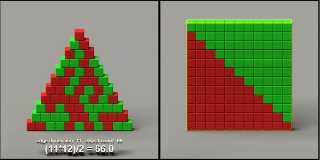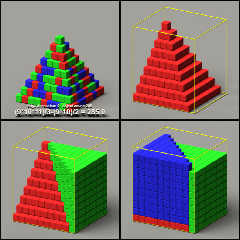|
 |
Hi everyone,
Today I figured out a couple of mathematical expressions to find the
number of bricks for any given 2d or 3d pyramid. I had previously
figured out the 2d version, but the equation was a bloated monstrosity.
The new one is much simpler!
My approach is a geometric one, where I try to fit a number of
asymmetrical (but numerically correct) versions of the pyramid into a
box or cube. The 2d version is rather straight-forward, while the 3d
version is a bit more complex.
In these images I attempt to illustrate the idea behind this method.
Displayed as text is the initial edge dimension. This is followed by the
object count acquired from an incremental value calculated as each
object was laid. Below that is the equation describing the number of
elements. This is calculated automatically at the time of parsing, based
on the edge dimension (concatenation of strings and all that). The total
number is given again as a proof that the method works. Following the
initial image, other images tell a story about how I came to arrive at a
working equation.
I know this has probably been done before, countless times, but it sure
was fun to arrive at this independently! It was a good mental exercise.
Now, for you math theorists out there, what is the next logical step in
the progression? I can see the equation as an extension of the 3d
version, but what would the object look like? Composed of hexagonal
prisms, perhaps...
Sam
Post a reply to this message
Attachments:
Download 'pyramid_math2d.jpg' (31 KB)
Download 'pyramid_math3d.jpg' (109 KB)
Preview of image 'pyramid_math2d.jpg'

Preview of image 'pyramid_math3d.jpg'

|
 |




![]()